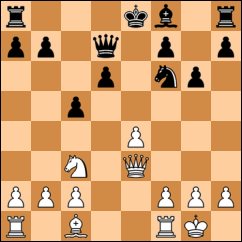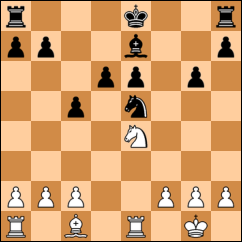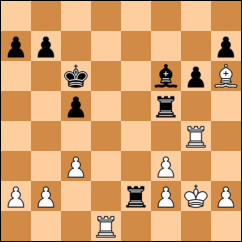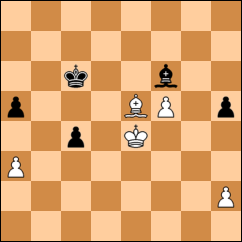I've heard it said that chess games are won by whoever makes the second-to-last mistake. It was true of a lot of our games this week, including this one.
Route 20 Chess Club
Freeport, Ill., Nov. 9, 2010
1.e4 e5 2.Nf3 Nc6 3.Bb5 d6?!
A passive alternative to 3...a6. If you're going to open up a pin on yourself, you should have a good reason.
4.d4 Bd7 5.0-0 Nf6 6.Nc3 exd4 7.Nxd4 Nxd4 8.Bxd7+ Qxd7 9.Qxd4 c5 10.Qe3 g6
11.e5?!
This has to be seen as bad, if only because it takes a decisive positional and development advantage and undermines its certainty. With a little advance preparation (11.Re1; 11.Qf3, 12.Rd1), the move e5 greatly increases in power.
11...Ng4
Steve gains a tempo, and now there's nothing backing up that e-pawn.
12.e6
Answering a threat with a counter-threat . . . and throwing away the advantage. Black, not white, will control the center now. Gary can avoid that sort of trouble by sidestepping the attacking knight with 12.Qg3 (or the slightly inferior 12.Qe2 or 12.Qf3). Regardless of which of those moves Gary chooses, Steve's best follow-up is to castle queenside.
12...Qxe6
12...fxe6 is slightly better. Why not 12...Nxe3, threatening to win the exchange? Because 13.exd7+ Kxd7 14.fxe3 wins a knight for a pawn, ruins black's chances of castling, reestablishes white in the center and opens up a file for white's king's rook. Danger: high voltage!
13.Qxe6+
Trading queens leaves a muddled position in which Steve, with his block of center pawns and his advanced knight, now has the advantage.
13...fxe6 14.Re1 Ne5 15.Ne4 Be7
Gary, as white, has a move that holds the line against Steve. What is it? (Highlight to reveal answer.)
16.Nxc5 Nf3+
Slightly better is 16...Kf7 17.Ne4. Steve can't play 16...dxc5 because of 17.Rxe5.
17.gxf3 dxc5 18.Rxe6
18...Kd7 19.Re4 Rhf8 20.Kg2 Rae8 21.Bh6 Rf5
The momentum begins to shift Gary's way again.
22.Rd1+ Kc6 23.Rg4
And the fish is let off the hook. The rook lift 23.Rd3 is significantly stronger. Now the game is starting to look drawish.
23...Bf6 24.c3 Re2
25.Bf8??
What's that about? This move overlooks the major positional threat of Steve's seventh-rank rook -- and the straightforward solution 25.Rd2 Rxd2 26.Bxd2. 25.Rb1 works also.
25...Rd5??
Returns the favor. 25...Rxb2 wins, period.
26.Rxd5 Kxd5 27.c4+ Kc6 28.Re4 Rxe4 29.fxe4 Bxb2
Heading back into Drawishland, with one point in Steve's favor: His pawns are all joined. Gary's are mostly isolated. But Gary repeatedly passes up the ramming shot a4 -- maybe because he's not sure he can stop Steve from promoting a passed pawn?
30.Bh6 Be5 31.f4 Bd4 32.Kf3 b5 33.cxb5+ Kxb5 34.f5
34.e5 offers better chances . . .
34...gxf5

. . . as does ignoring the f-pawn. In this lineup (diagram), both sides are in "pawn zugzwang." Capturing either of the middle pawns gives the opponent a passed pawn he didn't have before, while the bishops stand guard to pick off any would-be escapee who makes a break for the fence.
35.exf5 c4?
In this instance, following the dictum "Passed pawns must be pushed" is a mistake. Gary's bishop covers the c-pawn's promotion square, and without 35...Kc6 to block his king, he can try to slip into Steve's territory with 36.Ke4 and 37.Kd5 and alter the balance of power on the kingside.
36.Ke4 Bf6 37.a3??
A beautiful victory plan left lying in the gutter. 37.Kd5 c3 38.Ke6 almost guarantees that the f-pawn will promote -- for instance, 38...Bd4 39.f6 c2 40.f7 Bc5 41.Kd7 Kc4 42.Ke8 Kc3 43.Bc1 h5 44.f8Q.
37...a5
37...Bb2 is enough. That a-pawn has nowhere to go.
38.Bf8??
A game-ending blunder if Steve plays it right. The c-pawn's promotion square is no longer covered.
38...h5
38...Ka4!? is better. Even though Gary is defending the a-pawn with his bishop, this king move means that bishop can never leave its post. Gary will quickly find himself trying to fend off too many threats at once.
39.Bd6?
Still passing up the chance to invade with 39.Kd5. If Steve makes a break for it with 39...c3, then 40.Bh6 Ka4 41.Ke6 Bd4 42.Bc1 adroitly takes care of the problem.
39...Kc6??
39...Ka4 is still the better move, because Gary is running out of options. If he plays 40.Kd5 now, 40...c3 works: 41.Bf4 Kxa3 42.Kc4 c2 43.Bc1+ Bb2, and Gary can stop either the a-pawn or the c-pawn but not both; 41.h3 Bg5 42.f6 Bxf6 43.Bf4 Kxa3; and pretty much anything else Gary tries will be answered by 41...c2 42.Bf4 Kxa3.
40.Be5??
40.Bf4, getting back on the c1-h6 diagonal, is Gary's only chance to hold the draw. Anything else gives Steve a crack he can eventually pry open, but 40.Be5 is practically a capitulation, as the endgame makes clear.
40...Bxe5! 41.Kxe5 c3 42.f6 Kd7 43.f7 Ke7 44.Kd4 c2 45.Kd3 c1Q 46.f8Q+ Kxf8 47.a4 Qa3+ 48.Ke2 Qxa4 49.Kf3 Qb3+ 50.Kg2 a4 51.Kf1 a3 52.Kg1 a2 53.Kg2 a1Q 54.h3 Qba2+ 0-1









0 comments:
Post a Comment